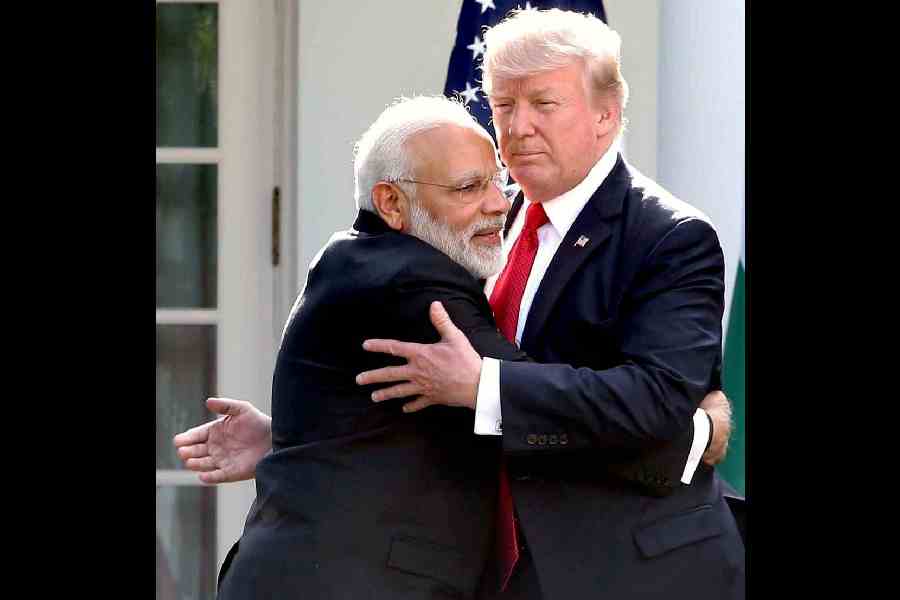US President Donald Trump has doubled the tariff whammy on India, adding an additional 25 per cent as lash for New Delhi’s continued purchase of oil from Russia.
India is one of the world’s largest importers of oil. In 2024, 36 per cent of India’s import quota of 85 per cent came from Russia. That heavy Russian quantum has now earned a heavy penalty from the US.
The US’s decision, which takes the total duty to an unprecedented 50 per cent and marks a sharp escalation in bilateral trade tensions, may effectively close the American market to a large chunk of Indian exports.
Citing an “unusual and extraordinary threat to the national security and foreign policy of the United States”, President Donald Trump on Wednesday signed an executive order slapping the additional duty on India that would come into effect from August 27. The goods that are already en route to the US must reach before September 17 to avoid the extra tariff.
After the new levy, India will face the highest tariff of 50 per cent along with Brazil. Chinese exports to the US currently attract a 30 per cent duty, and trade negotiations are on between the two countries.
The Trump administration is keen to have greater access to the Indian market for American products and the crushing tariff ordered on Wednesday may force the Modi government to offer concessions previously not considered, such as allowing limited import of some dairy products like cheese and condensed milk, experts said.
The external affairs ministry dubbed the punishing tariff as “unfair, unjustified and unreasonable”, adding that “India will take all actions necessary to protect its national interests”.
Disputing the US argument on Russian oil purchase, the ministry said in a statement: “We have already made clear our position on these issues, including the fact that our imports are based on market factors and done with the overall objective of ensuring the energy security of 1.4 billion people of India.”
It added: “It is therefore extremely unfortunate that the US should choose to impose additional tariffs on India for actions that several other countries are also taking in their own national interest.”
The executive order suggests that the sectors exempted from reciprocal tariffs, first announced by Trump on April 2, will be outside the purview of Wednesday’s announcement.
Consequently, petroleum products, finished pharmaceuticals, active pharmaceutical ingredients, smartphones and electronic products are unlikely to be impacted. Ironically, Russian crude oil refined by India if sold to US as finished product like petrol, diesel or ATF will not attract any duty because of the exemption.
Moreover, steel, aluminium and copper products, which are subjected to sectoral tariffs (50 per cent), will not be part of the new order.
Some trade experts believe that the three-week window offered by the Trump administration before delivering the crushing blow would allow some wiggle room for negotiations. A trade team from Washington is scheduled to visit India on August 25 for the sixth round of talks on a bilateral agreement.
Trump’s choice of words in the order also signalled his intention to leave some elbow room for manoeuvres.
“Should the government of the Russian Federation or a foreign country impacted by this order take significant steps to address the national emergency described in section 1 of this order and align sufficiently with the United States on national security, foreign policy, and economic matters, I may further modify this order,” the order stated.
However, he suggested a harsher penalty if a country chose to retaliate. “Should a foreign country retaliate against the United States in response to this action, I may modify this order to ensure the efficacy of the actions herein ordered,” the order read.
Congress leader Rahul Gandhi termed it “economic blackmail”.
“Trump’s 50% tariff is economic blackmail — an attempt to bully India into an unfair trade deal. PM Modi better not let his weakness override the interests of the Indian people,” Rahul posted on X.
Impact on India
The tariff threat by Trump is set to cast a cloud on the RBI’s projection that the Indian economy would grow by 6.5 per cent in 2025-26.
Earlier, the economists had suggested that a 25 per cent tariff could knock off India’s GDP growth by 0.3-0.6 per cent. The central bank itself had dialled down the growth forecast from 6.7 per cent to 6.5 per cent, citing “trade and related policy uncertainties”.
“With such obnoxious tariff rates, trade between the two nations would be practically dead,” said Madhavi Arora, economist at Emkay Global.
Ajay Sahai, director-general of the Federation of Indian Exports Organisation, dubbed Trump’s action “a severe setback for Indian exports, with nearly 55 per cent of our shipments to the US market directly affected”.
“The 50 per cent reciprocal tariff effectively imposes a cost burden, placing our exporters at a 30-35 per cent competitive disadvantage compared to peers from countries with a lesser reciprocal tariff. Many export orders have already been put on hold as buyers reassess sourcing decisions in light of higher landed costs,” Sahai said.
Labour-intensive sectors such as textiles, gems and jewellery, footwear, marine products and leather will be badly hit.
“For a large number of MSME-led sectors, absorbing this sudden cost escalation is simply not viable. Margins are already thin, and this additional blow could force firms to either scale down operations or lose long-standing clients,” Sahai said.
India purchased $52.7 billion worth of Russian oil in 2024, lower than China’s $62.6 billion. Ajay Srivastava, the founder of think tank GTRI, argued that Washington avoided targeting China because the US defence and technology sector was dependent on rare earths from Beijing.

